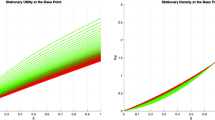Abstract
We consider the problem of efficiency and existence of a competitive equilibrium in exhaustible resource markets where extraction costs are nonconvex. Nonconvexity is shown to imply that (1) (efficient) extraction ceases to the left of the minimum efficient scale, i.e., where average costs exceed marginal costs; and (2) a competitive equilibrium does not exist. Introduction of a backstop technology (which induces a flat portion of the industry demand curve) restores both existence and efficiency, provided that the backstop price is sufficiently low. If firms face even a small amount of uncertainty regarding their rivals' stocks, a backstop technology is sufficient to restore existence of competitive equilibrium, even if the backstop price is very high. In this case, however, the competitive equilibrium is not efficient.
Similar content being viewed by others
References
Conrad, J. M. and Clark, C. W. (1987), Natural Resource Economics: Notes and Problems, Cambridge, Cambridge University Press.
Dasgupta, P. S. and Heal, G. M. (1979), Economic Theory and Exhaustible Resources, Cambridge, Cambridge University Press.
Eswaran, M., Lewis, T. R. and Heaps, T. (1983), ‘On the Nonexistence of Market Equilibria in Exhaustible Resource Markets with Decreasing Costs’, Journal of Political Economy 91: 154–167.
Farrow, S. (1985), ‘Testing the Efficiency of Extraction from a Stock Resource’, Journal of Political Economy 93: 452–487.
Gilbert, R. (1979), ‘Optimal Depletion of an Uncertain Stock’, Review of Economic Studies 46: 47–58.
Hartwick, J. M., Kemp, M. C. and Long, N.Van (1986), ‘Set-Up Costs and Theory of Exhaustible Resources’, Journal of Environmental Economics and Management 13: 212–224.
Hotelling, H. (1931), ‘The Economics of Exhaustible Resources’, Journal of Political Economy 39: 137–175.
Kemp, M. C. (1976), ‘How to Eat a Cake of Unknown Size’, in Three Topics in the Theory of International Trade, North Holland, Amsterdam.
Kimmel, S. (1984), ‘A Note on Extraction with Nonconvex Costs’, Journal of Political Economy 92: 1158–1167.
Lozada, G. A. (1992), ‘Existence of Equilibria in Exhaustible Resource Industries: Nonconvexities and Discrete Time’, Working paper, Texas A&M University.
Mason, C. (1990), ‘On Equilibrium in Exhaustible Resource Market with Non-Convex Costs’, Working Paper, University of Wyoming.
Mumy, Gene E. (1984), ‘Competitive Equilibria in Exhaustible Resource Markets with Decreasing Costs: A Comment on Eswaran, Lewis and Heaps' Demonstration of Nonexistence’, Journal of Political Economy 92: 1168–1174.
Schultze, William D. (1971), ‘The Optimal Use of Nonrenewable Resources: the Theory of Extraction’, Journal of Environmental Economics and Management 1: 53–73.
Scott, Anthony T. (1967), ‘The Theory of the Mine Under Conditions of Certainty’, Extractive Resources and Taxation, ed. Mason, Gaffney, University of Wisconsin Press, Madison.
Seierstad, Atle and Knut, Sydsaeter (1987), Optimal Control Theory with Economic Applications, North Holland, Amsterdam.
Author information
Authors and Affiliations
Rights and permissions
About this article
Cite this article
Fisher, A.C., Karp, L.S. Nonconvexity, efficiency and equilibrium in exhaustible resource depletion. Environmental and Resource Economics 3, 97–106 (1993). https://doi.org/10.1007/BF00338322
Issue Date:
DOI: https://doi.org/10.1007/BF00338322




